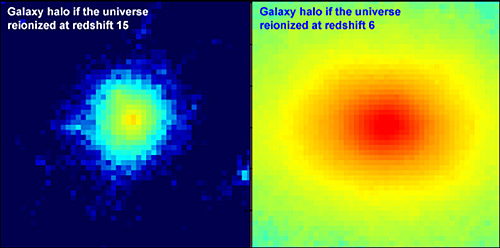







| BOOKS | F. A. Q. | ARTICLES | TALKS | ABOUT KEN | DONATE | BEYOND OUR KEN |
|---|

Text by Ken Croswell
Image by Kenji Bekki and Masashi Chiba/Astrophysical Journal Letters
If the universe reionized at redshift 15, it should have created compact stellar halos (left). But if the universe reionized later, at redshift 6, stellar halos should be more diffuse (right). The Milky Way's actual stellar halo matches the left model, suggesting the universe reionized around 260 million years after the big bang.
Published on Astronomy.com (June 16, 2005).
The timing of the universe's reionization left its mark on the Milky Way's stellar halo, say astronomers in Australia and Japan. The sooner this reionization occurred, the more concentrated our Galaxy�s stellar halo should be.
For most of its early life, the universe was not ionized: it had cooled off from the big bang, and its hydrogen and helium had their full complement of electrons. Then the first stars and quasars began to shine, ripping electrons from the hydrogen and helium. However, the exact timing of this reionization is unknown. It may have occurred as early as redshift 30, corresponding to a time just 100 million years after the big bang. Or it may have occurred as late as redshift 6, when the universe was 900 million years old.
Now Kenji Bekki of the University of New South Wales in Sydney, Australia, and Masashi Chiba of Tohoku University in Sendai, Japan, have proposed a way to determine when reionization occurred: observe how concentrated or spread out a galaxy's stellar halo is. Their work will be published in a future issue of Astrophysical Journal Letters.
The stellar halo is the Milky Way's oldest star population. Its brightest members are iron-poor globular star clusters. However, individual halo stars--such as Kapteyn's Star in Pictor, and Groombridge 1830 in Ursa Major--far outnumber cluster stars. Although the stellar halo envelops the Milky Way's disk, most halo stars and clusters reside closer to the Galaxy's center than the Sun does.
According to Bekki and Chiba, this concentration is a direct result of the epoch when the universe reionized itself. They conducted computer simulations of a developing galaxy as it came together in bits and pieces. The sooner reionization occurred, the sooner the Galaxy�s fragments ceased star formation. That's because an ionized universe allows extreme ultraviolet radiation to pass through, which destroys the cold molecular gas that gives birth to new stars.
Stars formed first in the densest of these clumps of gas and dust. If reionization occurred early, then stars formed in only the densest clumps before star formation ceased; these clumps then merged to form a stellar halo. Smaller clumps joined the Galaxy later; they added material to the outer part of the stellar halo.
Stars from these smaller clumps, if present, would have smeared out the stellar halo. But if reionization occurred early, these latecomers would be starless and wouldn't alter the stellar halo's tight concentration.
The astronomers say the Milky Way's actual stellar halo matches their model in which reionization occurred at redshift 15. This corresponds to a time 260 million years after the big bang. In particular, this model yields a stellar halo whose density varies as R�3.5, where R is the distance from the Milky Way�s center. In words, the equation says the number of halo stars per volume near the Sun is only 8.8 percent what it is at half the Sun's distance from the Galactic center. They note this relation holds throughout the Milky Way's stellar halo.
Bekki and Chiba suggest astronomers use large ground-based telescopes, such as Subaru in Hawaii, to observe the stellar halos of other giant spiral galaxies. These observations should further constrain the epoch of reionization.
Ken Croswell earned his Ph.D. from Harvard University for his study of the Milky Way's stellar halo and is the author of a book about the Milky Way entitled The Alchemy of the Heavens.
"An engaging account of the continuing discovery of our Galaxy."--New York Times Book Review. See all reviews of The Alchemy of the Heavens here.
| BOOKS | F. A. Q. | ARTICLES | TALKS | ABOUT KEN | DONATE | BEYOND OUR KEN |
|---|